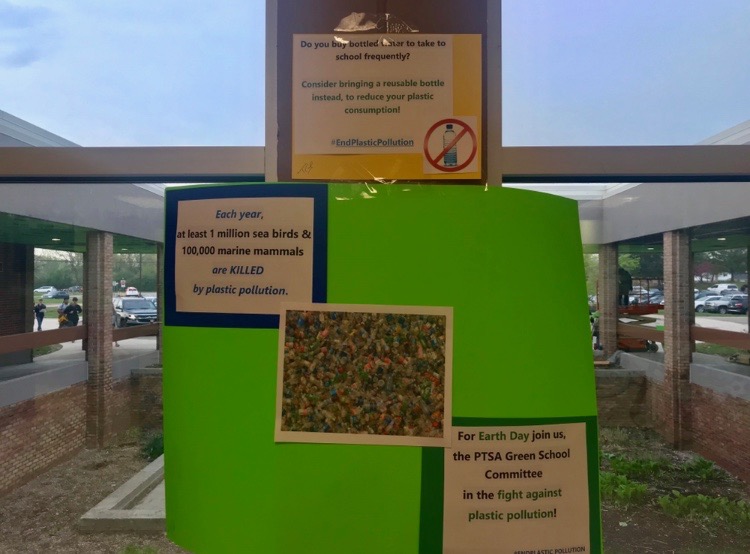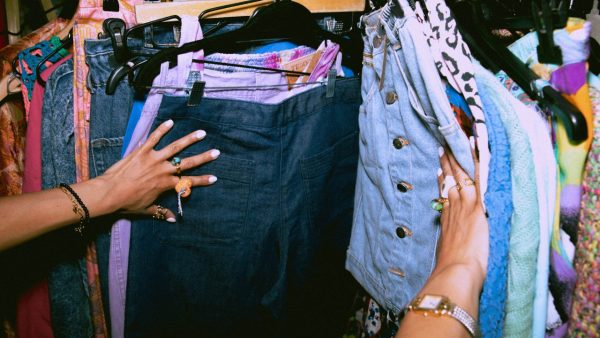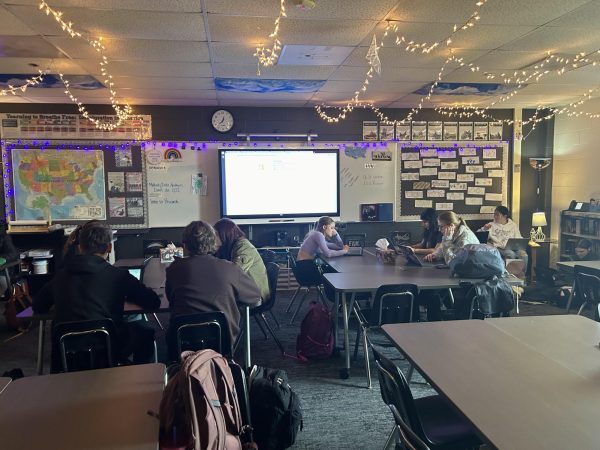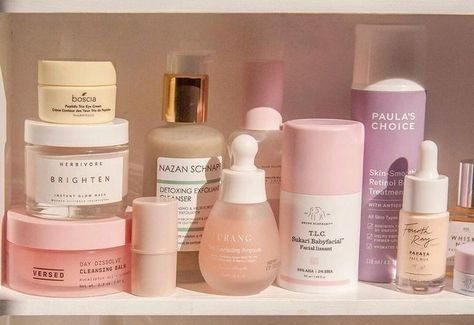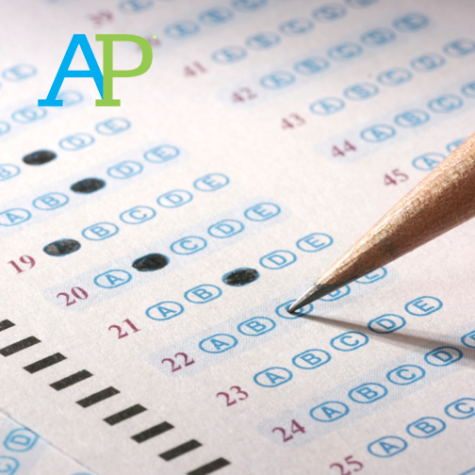Sorry Seafood Lovers, You’re Eating Plastic
Adam’s PTSA Green School Committee posts posters around the school to help raise awareness of ocean pollution.
How long does it take plastic to biodegrade? It does not. Plastic in the ocean merely breaks down into smaller pieces—which is bad news for seafood lovers. Microplastics, small particles of plastic, have already been found in many fish at supermarkets, according to Time.
Between 15 and 51 trillion microplastic particles have accumulated in the ocean a 2014 study shows. These particles are smaller than the width of a human hair and are hardly visible by the human eye. Microplastics are classified as pieces of plastic less than five millimeters in diameter. They result from the break down of larger pieces of plastic due to ultraviolet radiation from sunlight, chemical deterioration, and ocean waves. The amount of microplastics in the ocean are increasing rapidly, which can cause harm to marine life and consequently, humans.
Seventy-three percent of mesopelagic fish tested from the Northwest Atlantic ocean were found to have microplastics in their stomachs. The report published in February 2018 reveals the results to a study that tested the gut contents of seven species of fish found in the intermediate depths of the sea. The team extracted a total of 452 fragments of microplastics from the 233 studied fish.
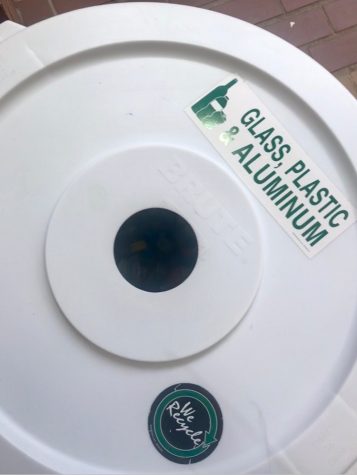
Adams encourages its students to recycle in the cafeteria and throughout the school.
Mesopelagic fish, those found in the intermediate depths of the sea, are important in global oceans. Many other fish prey on them, including tuna and swordfish—popular commercial food sources for humans. These mesopelagic fish transfer toxins and microplastics to their prey which can be potentially dangerous to other fish and humans.
“I think [ocean pollution] is a problem that people are waiting for it to be a problem for humans rather than it just being a problem for the animals. We’re only going to do something about it if we’re affected,” said sophomore Stephanie Adams.
The amount of plastic consumed by sealife only scratches the surface. Because plastic does not biodegrade, it joins trillions of other microplastics particles that are merely floating in the ocean. A recent study estimated there are 1.8 trillion microplastics in the Great Pacific Garbage Patch (GPGP). This patch is the largest site of plastic accumulation zones.
The Great Pacific Garbage Patch consists of two patches; the Western Garbage Patch is located near Japan and the Eastern Garbage Patch which is between California and Hawaii. These two vortices are joined together by a convergence zone where warm water from the South Pacific meets with colder water from the Arctic. The GPGP is confined by the North Pacific Subtropical Gyre—the largest ecosystem on planet Earth.
Because photos of islands of trash in the ocean circulate the internet, many people get the wrong idea about ocean pollution. Realistically, only six percent of plastic in the ocean is greater than five centimeters. The Great Pacific Garbage Patch is full of microplastics intermixed with far fewer larger items. These tiny particles merely give the patch a soupy look rather than an ‘ocean landfill’ look.
The large items that are denser than the water, sink to the bottom, which is what leads scientists to believe the ocean floor is crawling with pollution. Even the most remote places on Earth are affected by mankind. A study just recently revealed a plastic bag inside the Mariana Trench—36,000 feet deep. It was discovered as scientists studied a collection of photos and videos taken from over 5,000 dives in the past 30 years, known as the Deep-Sea Debris Database.
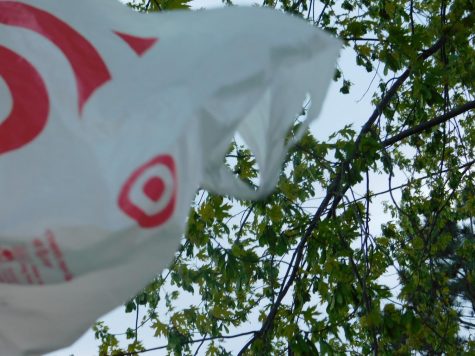
Plastic bags are a common form of plastic that pollutes the oceans.
The data from the study shows the majority of ocean pollutants are plastics, plastic bags in particular. However, plastic water bottles and plastic utensils were also common. In fact, 89 percent of the plastic pollutants found were single-use items.
The Deep-Sea Debris Database also found that 17 percent of the pictures taken showed interactions between marine life and pollutants, including animals entangled in it. This isn’t the only time pictures like this have been brought to light. Hundreds of heart-breaking pictures have gone viral, showing the direct effect plastic pollutants have on marine life.
Every year, 100,000 marine creatures die from plastic entanglement. Sea turtles, seals, seabirds, and fish are just a few of the approximant 700 marine species affected by plastic pollution. The alarming pictures of these animals tangled in or suffocated by man made pollutants have left many disturbed.
“Despite society’s moral desire to keep the oceans clean, it seems that few people actually work to make a significant difference. If we want our oceans to maintain the beauty that they currently have, then people need to actively get involved in programs aimed at ending the pollution and saving the affected species,” said sophomore Delaney Marino.
So, what programs are there that proactively help ocean pollution? Organizations like The Ocean Cleanup and 5 Gyres conduct research to help better understand ocean pollution and how to reduce the plastics in the oceans. The Take 3 organization spreads awareness and encourages people to help clean up beaches.
These three organizations are just a few of many, but all share one common theme: they rely on the people. They depend on donations and volunteers to help, but that isn’t the only way people can do their part to help the growing problem of ocean pollution.
“I try to avoid using single use plastic items like water bottles and straws. That kind of stuff just ends up in a landfill or in the ocean and it’s such a waste! I love to scuba dive and the amount of garbage I’ve seen while diving is disgusting. The easy convenience plastics are destroying our environment,” said student teacher Miranda Roberts.
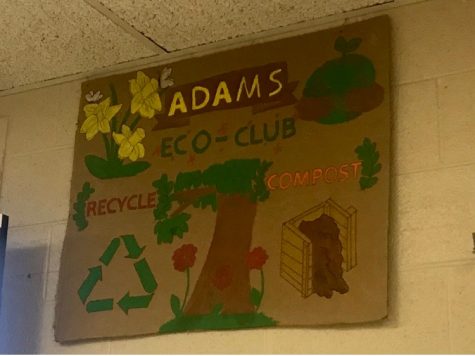
Adams’ Eco Club helps Adams stay eco-friendly.
Surrounded by the Great Lakes, the problem hits close to home for people in Michigan. Adams High School recognizes the problem and takes action. Adams’ Eco Club has helped the school help the environment by creating a recycling program and cleaning up the landscaping around the school. The PTSA’s Green School Committee has also helped with projects that create awareness of the problem.
Creating awareness is the key to finding a sufficient answer to controlling ocean pollution. Educating those with little knowledge of the effect man made plastic has on the environment will slowly lead to change.
“Pollution is a problem for everyone! We cannot continue to throw things away haphazardly, burn things, make things, and not expect there to be damaging effects for our environment, but for our own health,” said teacher Andrea Ciluffo.
Pollution is an issue people cannot ignore any longer. The easy-convenience plastics take their toll on the Earth and other life on it. As the human race continues to advance in ways never thought possible, the Earth is downing in pollution. Can the beauty of earth ever be restored, or is it already too late?

